Time processing for every ONNX nodes in a graph#
Links: notebook, html, PDF, python, slides, GitHub
The following notebook show how long the runtime spends in each node of an ONNX graph.
from jyquickhelper import add_notebook_menu
add_notebook_menu()
%load_ext mlprodict
%matplotlib inline
LogisticRegression#
from sklearn.datasets import load_iris
from sklearn.model_selection import train_test_split
from sklearn.linear_model import LogisticRegression
iris = load_iris()
X, y = iris.data, iris.target
X_train, X_test, y_train, y_test = train_test_split(X, y)
clr = LogisticRegression(solver='liblinear')
clr.fit(X_train, y_train)
LogisticRegression(solver='liblinear')
import numpy
from mlprodict.onnx_conv import to_onnx
onx = to_onnx(clr, X_test.astype(numpy.float32))
with open("logreg_time.onnx", "wb") as f:
f.write(onx.SerializeToString())
# add -l 1 if nothing shows up
%onnxview onx
from mlprodict.onnxrt import OnnxInference
import pandas
oinf = OnnxInference(onx)
res = oinf.run({'X': X_test}, node_time=True)
pandas.DataFrame(list(res[1]))
| i | name | op_type | time | |
|---|---|---|---|---|
| 0 | 0 | LinearClassifier | LinearClassifier | 0.199603 |
| 1 | 1 | Normalizer | Normalizer | 0.000091 |
| 2 | 2 | Cast | Cast | 0.000014 |
| 3 | 3 | ZipMap | ZipMap | 0.000016 |
oinf.run({'X': X_test})['output_probability'][:5]
{0: array([8.38235830e-01, 1.21554664e-03, 6.97352537e-04, 7.93823160e-01,
9.24825077e-01]),
1: array([0.16162989, 0.39692812, 0.25688601, 0.20607722, 0.07516498]),
2: array([1.34279470e-04, 6.01856333e-01, 7.42416637e-01, 9.96200831e-05,
9.94208860e-06])}
Measure time spent in each node#
With parameter node_time=True, method run returns the output and
time measurement.
exe = oinf.run({'X': X_test}, node_time=True)
exe[1]
[{'i': 0,
'name': 'LinearClassifier',
'op_type': 'LinearClassifier',
'time': 0.00015699999999974068},
{'i': 1,
'name': 'Normalizer',
'op_type': 'Normalizer',
'time': 5.43000000003957e-05},
{'i': 2, 'name': 'Cast', 'op_type': 'Cast', 'time': 1.1699999999947863e-05},
{'i': 3,
'name': 'ZipMap',
'op_type': 'ZipMap',
'time': 1.940000000111297e-05}]
import pandas
pandas.DataFrame(exe[1])
| i | name | op_type | time | |
|---|---|---|---|---|
| 0 | 0 | LinearClassifier | LinearClassifier | 0.000157 |
| 1 | 1 | Normalizer | Normalizer | 0.000054 |
| 2 | 2 | Cast | Cast | 0.000012 |
| 3 | 3 | ZipMap | ZipMap | 0.000019 |
Logistic regression: python runtime vs onnxruntime#
Function
enumerate_validated_operator_opsets
implements automated tests for every model with artificial data. Option
node_time automatically returns the time spent in each node and does
it multiple time.
from mlprodict.onnxrt.validate import enumerate_validated_operator_opsets
res = list(enumerate_validated_operator_opsets(
verbose=0, models={"LogisticRegression"}, opset_min=12,
runtime='python', debug=False, node_time=True,
filter_exp=lambda m, p: p == "b-cl"))
C:xavierdupre__home_github_forkscikit-learnsklearnlinear_model_logistic.py:1356: UserWarning: 'n_jobs' > 1 does not have any effect when 'solver' is set to 'liblinear'. Got 'n_jobs' = 4.
" = {}.".format(effective_n_jobs(self.n_jobs)))
C:xavierdupre__home_github_forkscikit-learnsklearnlinear_model_logistic.py:1356: UserWarning: 'n_jobs' > 1 does not have any effect when 'solver' is set to 'liblinear'. Got 'n_jobs' = 4.
" = {}.".format(effective_n_jobs(self.n_jobs)))
import pandas
df = pandas.DataFrame(res[0]['bench-batch'])
df['step'] = df.apply(lambda row: '{}-{}'.format(row['i'], row["name"]), axis=1)
df
| i | name | op_type | time | N | max_time | min_time | repeat | number | step | |
|---|---|---|---|---|---|---|---|---|---|---|
| 0 | 0 | LinearClassifier | LinearClassifier | 0.000018 | 1 | 0.000033 | 0.000015 | 20 | 30 | 0-LinearClassifier |
| 1 | 1 | Normalizer | Normalizer | 0.000017 | 1 | 0.000069 | 0.000012 | 20 | 30 | 1-Normalizer |
| 2 | 2 | Cast | Cast | 0.000004 | 1 | 0.000009 | 0.000003 | 20 | 30 | 2-Cast |
| 3 | 3 | ZipMap | ZipMap | 0.000005 | 1 | 0.000007 | 0.000004 | 20 | 30 | 3-ZipMap |
| 4 | 0 | LinearClassifier | LinearClassifier | 0.000020 | 10 | 0.000052 | 0.000017 | 20 | 20 | 0-LinearClassifier |
| 5 | 1 | Normalizer | Normalizer | 0.000015 | 10 | 0.000035 | 0.000013 | 20 | 20 | 1-Normalizer |
| 6 | 2 | Cast | Cast | 0.000004 | 10 | 0.000013 | 0.000003 | 20 | 20 | 2-Cast |
| 7 | 3 | ZipMap | ZipMap | 0.000004 | 10 | 0.000008 | 0.000004 | 20 | 20 | 3-ZipMap |
| 8 | 0 | LinearClassifier | LinearClassifier | 0.000024 | 100 | 0.000036 | 0.000019 | 10 | 8 | 0-LinearClassifier |
| 9 | 1 | Normalizer | Normalizer | 0.000018 | 100 | 0.000023 | 0.000015 | 10 | 8 | 1-Normalizer |
| 10 | 2 | Cast | Cast | 0.000004 | 100 | 0.000006 | 0.000003 | 10 | 8 | 2-Cast |
| 11 | 3 | ZipMap | ZipMap | 0.000007 | 100 | 0.000005 | 0.000004 | 10 | 8 | 3-ZipMap |
| 12 | 0 | LinearClassifier | LinearClassifier | 0.000051 | 1000 | 0.000057 | 0.000047 | 5 | 5 | 0-LinearClassifier |
| 13 | 1 | Normalizer | Normalizer | 0.000041 | 1000 | 0.000045 | 0.000040 | 5 | 5 | 1-Normalizer |
| 14 | 2 | Cast | Cast | 0.000003 | 1000 | 0.000004 | 0.000003 | 5 | 5 | 2-Cast |
| 15 | 3 | ZipMap | ZipMap | 0.000004 | 1000 | 0.000004 | 0.000004 | 5 | 5 | 3-ZipMap |
| 16 | 0 | LinearClassifier | LinearClassifier | 0.000315 | 10000 | 0.000328 | 0.000315 | 3 | 3 | 0-LinearClassifier |
| 17 | 1 | Normalizer | Normalizer | 0.000272 | 10000 | 0.000284 | 0.000256 | 3 | 3 | 1-Normalizer |
| 18 | 2 | Cast | Cast | 0.000004 | 10000 | 0.000004 | 0.000004 | 3 | 3 | 2-Cast |
| 19 | 3 | ZipMap | ZipMap | 0.000004 | 10000 | 0.000004 | 0.000004 | 3 | 3 | 3-ZipMap |
| 20 | 0 | LinearClassifier | LinearClassifier | 0.005634 | 100000 | 0.005634 | 0.005634 | 1 | 2 | 0-LinearClassifier |
| 21 | 1 | Normalizer | Normalizer | 0.004671 | 100000 | 0.004671 | 0.004671 | 1 | 2 | 1-Normalizer |
| 22 | 2 | Cast | Cast | 0.000024 | 100000 | 0.000024 | 0.000024 | 1 | 2 | 2-Cast |
| 23 | 3 | ZipMap | ZipMap | 0.000013 | 100000 | 0.000013 | 0.000013 | 1 | 2 | 3-ZipMap |
Following tables shows the time spent in each node, it is relative to the total time. For one observation, the runtime spends 10% of the time in ZipMap, it is only 1% or 2% with 10 observations. These proportions change due to the computing cost of each node.
piv = df.pivot('step', 'N', 'time')
total = piv.sum(axis=0)
piv / total
| N | 1 | 10 | 100 | 1000 | 10000 | 100000 |
|---|---|---|---|---|---|---|
| step | ||||||
| 0-LinearClassifier | 0.410138 | 0.459103 | 0.450882 | 0.512622 | 0.530490 | 0.544785 |
| 1-Normalizer | 0.390060 | 0.353622 | 0.350126 | 0.414227 | 0.456671 | 0.451642 |
| 2-Cast | 0.095729 | 0.089857 | 0.074343 | 0.034398 | 0.006092 | 0.002306 |
| 3-ZipMap | 0.104073 | 0.097418 | 0.124649 | 0.038753 | 0.006747 | 0.001267 |
The python implementation of ZipMap does not change the data but wraps in into a frozen class ArrayZipMapDitionary which mocks a list of dictionaries pandas can ingest to create a DataFrame. The cost is a fixed cost and does not depend on the number of processed rows.
from pyquickhelper.pycode.profiling import profile
bigX = numpy.random.randn(100000, X_test.shape[1]).astype(numpy.float32)
print(profile(lambda: oinf.run({'X': bigX}), pyinst_format="text")[1])
_ ._ __/__ _ _ _ _ _/_ Recorded: 00:28:08 Samples: 4 /_//_/// /_/ //_// / //_'/ // Duration: 0.009 CPU time: 0.031 / _/ v3.0.1 Program: c:python372_x64libsite-packagesipykernel_launcher.py -f C:UsersxavieAppDataRoamingjupyterruntimekernel-287476aa-b8ba-4140-902a-b0aad833ffd0.json 0.008 profile pyquickhelperpycodeprofiling.py:49 `- 0.008 <lambda> <ipython-input-13-ccd42692a7ed>:3 `- 0.008 run mlprodictonnxrtonnx_inference.py:475 `- 0.008 _run_sequence_runtime mlprodictonnxrtonnx_inference.py:558 `- 0.008 run mlprodictonnxrtonnx_inference_node.py:141 |- 0.005 run mlprodictonnxrtops_cpu_op.py:417 | `- 0.005 run mlprodictonnxrtops_cpu_op.py:298 | `- 0.005 _run mlprodictonnxrtops_cpuop_linear_classifier.py:40 | |- 0.003 [self] | `- 0.002 argmax <__array_function__ internals>:2 | `- 0.002 argmax numpycorefromnumeric.py:1112 | [3 frames hidden] numpy | 0.002 _wrapfunc numpycorefromnumeric.py:55 `- 0.003 run mlprodictonnxrtops_cpu_op.py:383 `- 0.003 run mlprodictonnxrtops_cpu_op.py:298 `- 0.003 _run mlprodictonnxrtops_cpuop_normalizer.py:66 `- 0.003 norm_l1 mlprodictonnxrtops_cpuop_normalizer.py:42 `- 0.003 _norm_L1_inplace mlprodictonnxrtops_cpuop_normalizer.py:49 |- 0.002 [self] `- 0.002 _sum numpycore_methods.py:36 [2 frames hidden] numpy
The class ArrayZipMapDictionary is fast to build but has an overhead after that because it builds data when needed.
res = oinf.run({'X': bigX})
prob = res['output_probability']
type(prob)
mlprodict.onnxrt.ops_cpu.op_zipmap.ArrayZipMapDictionary
%timeit pandas.DataFrame(prob)
721 ms ± 54.5 ms per loop (mean ± std. dev. of 7 runs, 1 loop each)
list_of_dict = [v.asdict() for v in prob]
%timeit pandas.DataFrame(list_of_dict)
108 ms ± 2.01 ms per loop (mean ± std. dev. of 7 runs, 10 loops each)
But if you just need to do the following:
%timeit pandas.DataFrame(prob).values
713 ms ± 56.6 ms per loop (mean ± std. dev. of 7 runs, 1 loop each)
Then, you can just do that:
print(prob.columns)
%timeit prob.values
[0, 1, 2]
390 ns ± 51.2 ns per loop (mean ± std. dev. of 7 runs, 1000000 loops each)
And then:
%timeit -n 100 pandas.DataFrame(prob.values, columns=prob.columns)
215 µs ± 82.6 µs per loop (mean ± std. dev. of 7 runs, 100 loops each)
We can then compare to what onnxruntime would do when the runtime is called indenpently for each node. We use the runtime named onnxruntime2. Class OnnxInference splits the ONNX graph into multiple ONNX graphs, one for each node, and then calls onnxruntime for each of them indenpently. Python handles the graph logic.
res = list(enumerate_validated_operator_opsets(
verbose=0, models={"LogisticRegression"}, opset_min=12,
runtime='onnxruntime2', debug=False, node_time=True))
C:xavierdupre__home_github_forkscikit-learnsklearnlinear_model_logistic.py:1356: UserWarning: 'n_jobs' > 1 does not have any effect when 'solver' is set to 'liblinear'. Got 'n_jobs' = 4.
" = {}.".format(effective_n_jobs(self.n_jobs)))
C:xavierdupre__home_github_forkscikit-learnsklearnlinear_model_logistic.py:1356: UserWarning: 'n_jobs' > 1 does not have any effect when 'solver' is set to 'liblinear'. Got 'n_jobs' = 4.
" = {}.".format(effective_n_jobs(self.n_jobs)))
C:xavierdupre__home_github_forkscikit-learnsklearnlinear_model_logistic.py:1356: UserWarning: 'n_jobs' > 1 does not have any effect when 'solver' is set to 'liblinear'. Got 'n_jobs' = 4.
" = {}.".format(effective_n_jobs(self.n_jobs)))
C:xavierdupre__home_github_forkscikit-learnsklearnlinear_model_logistic.py:1356: UserWarning: 'n_jobs' > 1 does not have any effect when 'solver' is set to 'liblinear'. Got 'n_jobs' = 4.
" = {}.".format(effective_n_jobs(self.n_jobs)))
C:xavierdupre__home_github_forkscikit-learnsklearnlinear_model_logistic.py:1356: UserWarning: 'n_jobs' > 1 does not have any effect when 'solver' is set to 'liblinear'. Got 'n_jobs' = 4.
" = {}.".format(effective_n_jobs(self.n_jobs)))
C:xavierdupre__home_github_forkscikit-learnsklearnlinear_model_logistic.py:1356: UserWarning: 'n_jobs' > 1 does not have any effect when 'solver' is set to 'liblinear'. Got 'n_jobs' = 4.
" = {}.".format(effective_n_jobs(self.n_jobs)))
C:xavierdupre__home_github_forkscikit-learnsklearnlinear_model_logistic.py:1356: UserWarning: 'n_jobs' > 1 does not have any effect when 'solver' is set to 'liblinear'. Got 'n_jobs' = 4.
" = {}.".format(effective_n_jobs(self.n_jobs)))
C:xavierdupre__home_github_forkscikit-learnsklearnlinear_model_logistic.py:1356: UserWarning: 'n_jobs' > 1 does not have any effect when 'solver' is set to 'liblinear'. Got 'n_jobs' = 4.
" = {}.".format(effective_n_jobs(self.n_jobs)))
C:xavierdupre__home_github_forkscikit-learnsklearnlinear_model_logistic.py:1356: UserWarning: 'n_jobs' > 1 does not have any effect when 'solver' is set to 'liblinear'. Got 'n_jobs' = 4.
" = {}.".format(effective_n_jobs(self.n_jobs)))
C:xavierdupre__home_github_forkscikit-learnsklearnlinear_model_logistic.py:1356: UserWarning: 'n_jobs' > 1 does not have any effect when 'solver' is set to 'liblinear'. Got 'n_jobs' = 4.
" = {}.".format(effective_n_jobs(self.n_jobs)))
res0 = None
for i, r in enumerate(res):
if "available-ERROR" in r:
print(i, str(r['available-ERROR']).split("\n")[0])
elif res0 is None:
res0 = r
0 Unable to load node 'ZipMap' (output type was inferred)
1 Unable to load node 'ZipMap' (output type was inferred)
4 Unable to load node 'LinearClassifier' (output type was guessed)
5 Unable to load node 'LinearClassifier' (output type was guessed)
6 Unable to load node 'LinearClassifier' (output type was guessed)
7 Unable to load node 'LinearClassifier' (output type was guessed)
8 Unable to load node 'ZipMap' (output type was inferred)
9 Unable to load node 'ZipMap' (output type was inferred)
if '_6ort_run_batch_exc' in res[0]:
m = "Something went wrong.", res[0]['_6ort_run_batch_exc']
else:
df = pandas.DataFrame(res0['bench-batch'])
print(df)
df['step'] = df.apply(lambda row: '{}-{}'.format(row['i'], row["name"]), axis=1)
piv = df.pivot('step', 'N', 'time')
total = piv.sum(axis=0)
m = piv / total
m
i name op_type time N max_time 0 0 LinearClassifier LinearClassifier 0.000052 1 0.000190 1 0 LinearClassifier LinearClassifier 0.000044 10 0.000070 2 0 LinearClassifier LinearClassifier 0.000071 100 0.000133 3 0 LinearClassifier LinearClassifier 0.000066 1000 0.000079 4 0 LinearClassifier LinearClassifier 0.000409 10000 0.000408 5 0 LinearClassifier LinearClassifier 0.003275 100000 0.003275 min_time repeat number 0 0.000028 20 30 1 0.000031 20 20 2 0.000046 10 8 3 0.000057 5 5 4 0.000365 3 3 5 0.003275 1 2
| N | 1 | 10 | 100 | 1000 | 10000 | 100000 |
|---|---|---|---|---|---|---|
| step | ||||||
| 0-LinearClassifier | 1.0 | 1.0 | 1.0 | 1.0 | 1.0 | 1.0 |
onnxruntime creates a new container each time a ZipMap is executed. That’s whay it takes that much time and the ratio increases when the number of observations increases.
GaussianProcessRegressor#
This operator is slow for small batches compare to scikit-learn but closes the gap as the batch size increases. Let’s see where the time goes.
from onnx.defs import onnx_opset_version
from mlprodict.tools.asv_options_helper import get_opset_number_from_onnx
onnx_opset_version(), get_opset_number_from_onnx()
(12, 12)
res = list(enumerate_validated_operator_opsets(
verbose=1, models={"GaussianProcessRegressor"},
opset_min=get_opset_number_from_onnx(),
opset_max=get_opset_number_from_onnx(),
runtime='python', debug=False, node_time=True,
filter_exp=lambda m, p: p == "b-reg"))
[enumerate_validated_operator_opsets] opset in [12, 12].
GaussianProcessRegressor : 0%| | 0/1 [00:00<?, ?it/s]
[enumerate_compatible_opset] opset in [12, 12].
GaussianProcessRegressor : 100%|██████████| 1/1 [00:05<00:00, 5.66s/it]
res0 = None
for i, r in enumerate(res):
if "available-ERROR" in r:
print(i, str(r['available-ERROR']).split("\n")[0])
elif res0 is None:
res0 = r
df = pandas.DataFrame(res0['bench-batch'])
df['step'] = df.apply(lambda row: '{0:02d}-{1}'.format(row['i'], row["name"]), axis=1)
df.head()
| i | name | op_type | time | N | max_time | min_time | repeat | number | step | |
|---|---|---|---|---|---|---|---|---|---|---|
| 0 | 0 | kgpd_CDist | CDist | 0.000033 | 1 | 0.000045 | 0.000027 | 20 | 30 | 00-kgpd_CDist |
| 1 | 1 | kgpd_Div | Div | 0.000009 | 1 | 0.000016 | 0.000007 | 20 | 30 | 01-kgpd_Div |
| 2 | 2 | kgpd_Mul | Mul | 0.000006 | 1 | 0.000007 | 0.000005 | 20 | 30 | 02-kgpd_Mul |
| 3 | 3 | kgpd_Sin | Sin | 0.000007 | 1 | 0.000009 | 0.000006 | 20 | 30 | 03-kgpd_Sin |
| 4 | 4 | kgpd_Div1 | Div | 0.000007 | 1 | 0.000008 | 0.000005 | 20 | 30 | 04-kgpd_Div1 |
pivpy = df.pivot('step', 'N', 'time')
total = pivpy.sum(axis=0)
pivpy / total
| N | 1 | 10 | 100 | 1000 | 10000 | 100000 |
|---|---|---|---|---|---|---|
| step | ||||||
| 00-kgpd_CDist | 0.311496 | 0.300665 | 0.244035 | 0.227984 | 0.264447 | 0.288546 |
| 01-kgpd_Div | 0.082535 | 0.067193 | 0.028348 | 0.011667 | 0.012230 | 0.015447 |
| 02-kgpd_Mul | 0.059840 | 0.050664 | 0.018670 | 0.006959 | 0.010950 | 0.012468 |
| 03-kgpd_Sin | 0.067037 | 0.086529 | 0.106165 | 0.113068 | 0.102102 | 0.107563 |
| 04-kgpd_Div1 | 0.061852 | 0.053088 | 0.025749 | 0.010935 | 0.009810 | 0.009875 |
| 05-kgpd_Pow | 0.072520 | 0.166539 | 0.361318 | 0.438253 | 0.418169 | 0.404182 |
| 06-kgpd_Mul1 | 0.057508 | 0.050477 | 0.020386 | 0.010334 | 0.009079 | 0.010466 |
| 07-kgpd_Exp | 0.067885 | 0.098850 | 0.150876 | 0.168079 | 0.165177 | 0.145106 |
| 08-gpr_MatMul | 0.137546 | 0.064570 | 0.025069 | 0.009029 | 0.007134 | 0.006159 |
| 09-gpr_Add | 0.081782 | 0.061424 | 0.019383 | 0.003692 | 0.000903 | 0.000190 |
ax = (pivpy / total).T.plot(logx=True, figsize=(14, 4))
ax.set_ylim([0,1])
ax.set_title("Time spent in each node relatively to the total time\npython runtime");
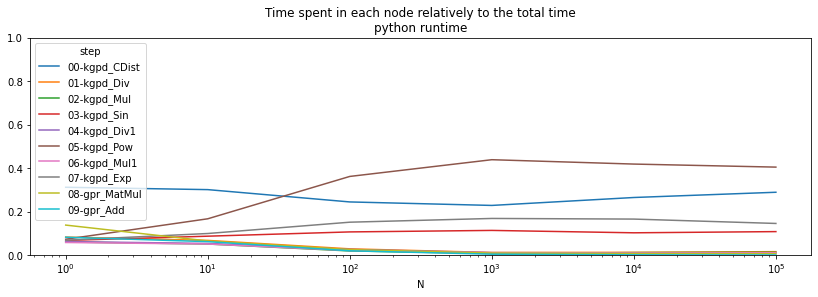
The operator Scan is clearly time consuming when the batch size is small. onnxruntime is more efficient for this one.
res = list(enumerate_validated_operator_opsets(
verbose=1, models={"GaussianProcessRegressor"},
opset_min=get_opset_number_from_onnx(),
opset_max=get_opset_number_from_onnx(),
runtime='onnxruntime2', debug=False, node_time=True,
filter_exp=lambda m, p: p == "b-reg"))
[enumerate_validated_operator_opsets] opset in [12, 12].
GaussianProcessRegressor : 0%| | 0/1 [00:00<?, ?it/s]
[enumerate_compatible_opset] opset in [12, 12].
GaussianProcessRegressor : 100%|██████████| 1/1 [00:06<00:00, 6.84s/it]
try:
df = pandas.DataFrame(res[0]['bench-batch'])
except KeyError as e:
print("No model available.")
r, df = None, None
if df is not None:
df['step'] = df.apply(lambda row: '{0:02d}-{1}'.format(row['i'], row["name"]), axis=1)
pivort = df.pivot('step', 'N', 'time')
total = pivort.sum(axis=0)
r = pivort / total
r
| N | 1 | 10 | 100 | 1000 | 10000 | 100000 |
|---|---|---|---|---|---|---|
| step | ||||||
| 00-kgpd_CDist | 0.114001 | 0.120884 | 0.128845 | 0.148042 | 0.156776 | 0.180377 |
| 01-kgpd_Div | 0.101792 | 0.098622 | 0.085983 | 0.085108 | 0.086603 | 0.084520 |
| 02-kgpd_Mul | 0.099980 | 0.097547 | 0.084001 | 0.064706 | 0.072849 | 0.081023 |
| 03-kgpd_Sin | 0.089632 | 0.103505 | 0.194194 | 0.301002 | 0.245769 | 0.260717 |
| 04-kgpd_Div1 | 0.099119 | 0.096737 | 0.088709 | 0.063237 | 0.095840 | 0.091635 |
| 05-kgpd_Pow | 0.108045 | 0.098307 | 0.081161 | 0.064898 | 0.079015 | 0.076962 |
| 06-kgpd_Mul1 | 0.098561 | 0.098475 | 0.082770 | 0.063557 | 0.087732 | 0.076762 |
| 07-kgpd_Exp | 0.090019 | 0.087015 | 0.086282 | 0.088542 | 0.103798 | 0.087690 |
| 08-gpr_MatMul | 0.100426 | 0.102766 | 0.106220 | 0.102751 | 0.069157 | 0.059617 |
| 09-gpr_Add | 0.098425 | 0.096143 | 0.061836 | 0.018155 | 0.002462 | 0.000696 |
if r is not None:
ax = (pivort / total).T.plot(logx=True, figsize=(14, 4))
ax.set_ylim([0,1])
ax.set_title("Time spent in each node relatively to the total time\nonnxtunime");
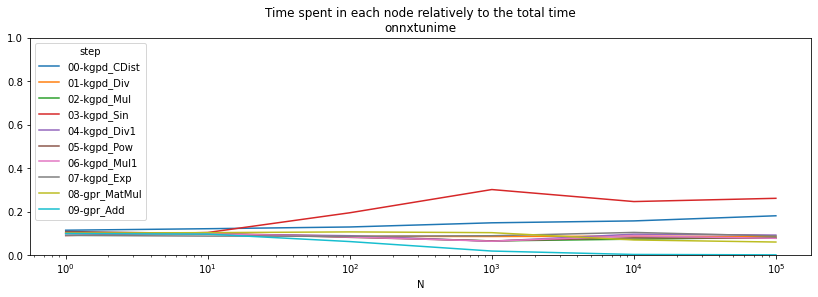
The results are relative. Let’s see which runtime is best node by node.
if r is not None:
r = (pivort - pivpy) / pivpy
r
| N | 1 | 10 | 100 | 1000 | 10000 | 100000 |
|---|---|---|---|---|---|---|
| step | ||||||
| 00-kgpd_CDist | -0.239113 | -0.367743 | -0.630420 | -0.703226 | -0.677041 | -0.631775 |
| 01-kgpd_Div | 1.564119 | 1.308106 | 1.123155 | 2.333824 | 2.857590 | 2.223117 |
| 02-kgpd_Mul | 2.473648 | 2.027773 | 2.149388 | 3.249448 | 2.624165 | 2.828025 |
| 03-kgpd_Sin | 1.779780 | 0.881090 | 0.280401 | 0.216680 | 0.311288 | 0.427768 |
| 04-kgpd_Div1 | 2.331710 | 1.865534 | 1.411570 | 1.642922 | 4.321977 | 4.466249 |
| 05-kgpd_Pow | 2.097502 | -0.071724 | -0.842765 | -0.932321 | -0.897065 | -0.887837 |
| 06-kgpd_Mul1 | 2.563218 | 2.067909 | 1.842112 | 1.811019 | 4.263897 | 3.320524 |
| 07-kgpd_Exp | 1.756911 | 0.384288 | -0.599693 | -0.759241 | -0.657668 | -0.644029 |
| 08-gpr_MatMul | 0.517953 | 1.502798 | 1.965953 | 4.201281 | 4.281286 | 4.701255 |
| 09-gpr_Add | 1.502111 | 1.461452 | 1.233097 | 1.247736 | 0.486358 | 1.160395 |
Based on this, onnxruntime is faster for operators Scan, Pow, Exp and slower for all the others.
Measuring the time with a custom dataset#
We use the example Comparison of kernel ridge and Gaussian process regression.
import numpy
import pandas
import matplotlib.pyplot as plt
from sklearn.kernel_ridge import KernelRidge
from sklearn.model_selection import GridSearchCV
from sklearn.gaussian_process import GaussianProcessRegressor
from sklearn.gaussian_process.kernels import WhiteKernel, ExpSineSquared
rng = numpy.random.RandomState(0)
# Generate sample data
X = 15 * rng.rand(100, 1)
y = numpy.sin(X).ravel()
y += 3 * (0.5 - rng.rand(X.shape[0])) # add noise
gp_kernel = ExpSineSquared(1.0, 5.0, periodicity_bounds=(1e-2, 1e1))
gpr = GaussianProcessRegressor(kernel=gp_kernel)
gpr.fit(X, y)
C:xavierdupre__home_github_forkscikit-learnsklearngaussian_processkernels.py:409: ConvergenceWarning: The optimal value found for dimension 0 of parameter length_scale is close to the specified lower bound 1e-05. Decreasing the bound and calling fit again may find a better value. ConvergenceWarning) C:xavierdupre__home_github_forkscikit-learnsklearngaussian_processkernels.py:418: ConvergenceWarning: The optimal value found for dimension 0 of parameter periodicity is close to the specified upper bound 10.0. Increasing the bound and calling fit again may find a better value. ConvergenceWarning)
GaussianProcessRegressor(kernel=ExpSineSquared(length_scale=1, periodicity=5))
onx = to_onnx(gpr, X_test.astype(numpy.float64))
with open("gpr_time.onnx", "wb") as f:
f.write(onx.SerializeToString())
%onnxview onx -r 1
from mlprodict.tools import get_ir_version_from_onnx
onx.ir_version = get_ir_version_from_onnx()
oinfpy = OnnxInference(onx, runtime="python")
oinfort = OnnxInference(onx, runtime="onnxruntime2")
runtime==onnxruntime2 tells the class OnnxInference to use
onnxruntime for every node independently, there are as many calls as
there are nodes in the graph.
respy = oinfpy.run({'X': X_test}, node_time=True)
try:
resort = oinfort.run({'X': X_test}, node_time=True)
except Exception as e:
print(e)
resort = None
if resort is not None:
df = pandas.DataFrame(respy[1]).merge(pandas.DataFrame(resort[1]), on=["i", "name", "op_type"],
suffixes=("_py", "_ort"))
df['delta'] = df.time_ort - df.time_py
else:
df = None
df
| i | name | op_type | time_py | time_ort | delta | |
|---|---|---|---|---|---|---|
| 0 | 0 | Sc_Scan | Scan | 0.007998 | 0.005970 | -0.002028 |
| 1 | 1 | kgpd_Transpose | Transpose | 0.000032 | 0.000599 | 0.000567 |
| 2 | 2 | kgpd_Sqrt | Sqrt | 0.000063 | 0.000112 | 0.000049 |
| 3 | 3 | kgpd_Div | Div | 0.000143 | 0.000097 | -0.000045 |
| 4 | 4 | kgpd_Mul | Mul | 0.000038 | 0.000321 | 0.000283 |
| 5 | 5 | kgpd_Sin | Sin | 0.000095 | 0.000146 | 0.000051 |
| 6 | 6 | kgpd_Div1 | Div | 0.000027 | 0.000096 | 0.000069 |
| 7 | 7 | kgpd_Pow | Pow | 0.000299 | 0.000104 | -0.000196 |
| 8 | 8 | kgpd_Mul1 | Mul | 0.000032 | 0.000097 | 0.000065 |
| 9 | 9 | kgpd_Exp | Exp | 0.000383 | 0.000111 | -0.000271 |
| 10 | 10 | gpr_MatMul | MatMul | 0.000080 | 0.004359 | 0.004279 |
| 11 | 11 | gpr_Add | Add | 0.000034 | 0.000165 | 0.000131 |
The following function runs multiple the same inference and aggregates the results node by node.
from mlprodict.onnxrt.validate.validate import benchmark_fct
res = benchmark_fct(lambda X: oinfpy.run({'X': X_test}, node_time=True),
X_test, node_time=True)
df = pandas.DataFrame(res)
df[df.N == 100]
| i | name | op_type | time | N | max_time | min_time | repeat | number | |
|---|---|---|---|---|---|---|---|---|---|
| 24 | 0 | Sc_Scan | Scan | 0.004154 | 100 | 0.004330 | 0.003843 | 10 | 8 |
| 25 | 1 | kgpd_Transpose | Transpose | 0.000013 | 100 | 0.000019 | 0.000010 | 10 | 8 |
| 26 | 2 | kgpd_Sqrt | Sqrt | 0.000018 | 100 | 0.000022 | 0.000015 | 10 | 8 |
| 27 | 3 | kgpd_Div | Div | 0.000025 | 100 | 0.000092 | 0.000015 | 10 | 8 |
| 28 | 4 | kgpd_Mul | Mul | 0.000012 | 100 | 0.000019 | 0.000009 | 10 | 8 |
| 29 | 5 | kgpd_Sin | Sin | 0.000057 | 100 | 0.000070 | 0.000050 | 10 | 8 |
| 30 | 6 | kgpd_Div1 | Div | 0.000014 | 100 | 0.000017 | 0.000011 | 10 | 8 |
| 31 | 7 | kgpd_Pow | Pow | 0.000172 | 100 | 0.000198 | 0.000155 | 10 | 8 |
| 32 | 8 | kgpd_Mul1 | Mul | 0.000020 | 100 | 0.000101 | 0.000009 | 10 | 8 |
| 33 | 9 | kgpd_Exp | Exp | 0.000213 | 100 | 0.000249 | 0.000193 | 10 | 8 |
| 34 | 10 | gpr_MatMul | MatMul | 0.000034 | 100 | 0.000047 | 0.000026 | 10 | 8 |
| 35 | 11 | gpr_Add | Add | 0.000013 | 100 | 0.000019 | 0.000011 | 10 | 8 |
df100 = df[df.N == 100]
%matplotlib inline
fig, ax = plt.subplots(1, 1, figsize=(14, 4))
ax.bar(df100.i, df100.time, align='center', color='orange')
ax.set_xticks(df100.i)
ax.set_yscale('log')
ax.set_xticklabels(df100.op_type)
ax.errorbar(df100.i, df100.time,
numpy.abs(df100[["min_time", "max_time"]].T.values - df100.time.values.ravel()),
uplims=True, lolims=True, color='blue')
ax.set_title("Time spent in each node for 100 observations\nGaussianProcess");
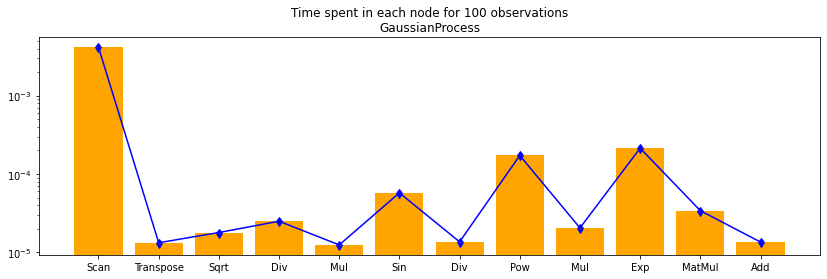
df100c = df100.cumsum()
fig, ax = plt.subplots(1, 1, figsize=(14, 4))
ax.bar(df100.i, df100c.time, align='center', color='orange')
ax.set_xticks(df100.i)
#ax.set_yscale('log')
ax.set_ylim([df100c.min_time.min(), df100c.max_time.max()])
ax.set_xticklabels(df100.op_type)
ax.errorbar(df100.i, df100c.time,
numpy.abs((df100c[["min_time", "max_time"]].T.values - df100c.time.values.ravel())),
uplims=True, lolims=True)
ax.set_title("Cumulated time spent in each node for 100 observations\nGaussianProcess");
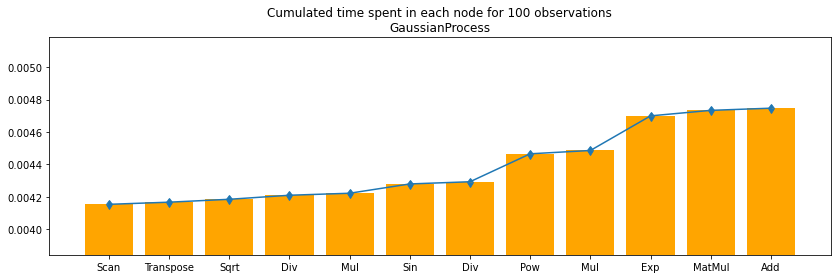
onnxruntime2 / onnxruntime1#
The runtime onnxruntime1 uses onnxruntime for the whole ONNX
graph. There is no way to get the computation time for each node except
if we create a ONNX graph for each intermediate node.
oinfort1 = OnnxInference(onx, runtime='onnxruntime1')
split = oinfort1.build_intermediate()
split
OrderedDict([('scan0', OnnxInference(...)),
('scan1', OnnxInference(...)),
('kgpd_transposed0', OnnxInference(...)),
('kgpd_Y0', OnnxInference(...)),
('kgpd_C03', OnnxInference(...)),
('kgpd_C02', OnnxInference(...)),
('kgpd_output02', OnnxInference(...)),
('kgpd_C01', OnnxInference(...)),
('kgpd_Z0', OnnxInference(...)),
('kgpd_C0', OnnxInference(...)),
('kgpd_output01', OnnxInference(...)),
('gpr_Y0', OnnxInference(...)),
('GPmean', OnnxInference(...))])
dfs = []
for k, v in split.items():
print("node", k)
res = benchmark_fct(lambda x: v.run({'X': x}), X_test)
df = pandas.DataFrame(res)
df['name'] = k
dfs.append(df.reset_index(drop=False))
node scan0
node scan1
node kgpd_transposed0
node kgpd_Y0
node kgpd_C03
node kgpd_C02
node kgpd_output02
node kgpd_C01
node kgpd_Z0
node kgpd_C0
node kgpd_output01
node gpr_Y0
node GPmean
df = pandas.concat(dfs)
df.head()
| index | 1 | 10 | 100 | 1000 | 10000 | 100000 | name | |
|---|---|---|---|---|---|---|---|---|
| 0 | average | 0.000623 | 0.000592 | 0.000754 | 0.002202 | 0.017529 | 0.201192 | scan0 |
| 1 | deviation | 0.000115 | 0.000030 | 0.000034 | 0.000026 | 0.000976 | 0.000000 | scan0 |
| 2 | min_exec | 0.000541 | 0.000537 | 0.000657 | 0.002169 | 0.016677 | 0.201192 | scan0 |
| 3 | max_exec | 0.000980 | 0.000639 | 0.000780 | 0.002239 | 0.018896 | 0.201192 | scan0 |
| 4 | repeat | 20.000000 | 20.000000 | 10.000000 | 5.000000 | 3.000000 | 1.000000 | scan0 |
df100c = df[df['index'] == "average"]
df100c_min = df[df['index'] == "min_exec"]
df100c_max = df[df['index'] == "max_exec"]
ave = df100c.iloc[:, 4]
ave_min = df100c_min.iloc[:, 4]
ave_max = df100c_max.iloc[:, 4]
ave.shape, ave_min.shape, ave_max.shape
index = numpy.arange(ave.shape[0])
fig, ax = plt.subplots(1, 1, figsize=(14, 4))
ax.bar(index, ave, align='center', color='orange')
ax.set_xticks(index)
ax.set_xticklabels(df100c.name)
for tick in ax.get_xticklabels():
tick.set_rotation(20)
ax.errorbar(index, ave,
numpy.abs((numpy.vstack([ave_min.values, ave_max.values]) - ave.values.ravel())),
uplims=True, lolims=True)
ax.set_title("Cumulated time spent in each node for 100 "
"observations\nGaussianProcess and onnxruntime1");
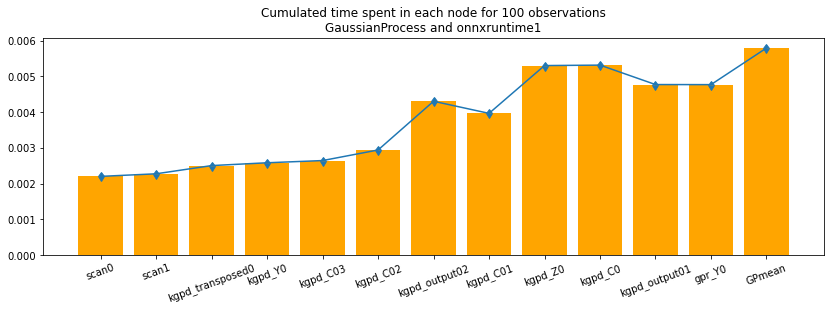
The visual graph helps matching the output names with the operator type. The curve is not monotononic because each experiment computes every output from the start. The number of repetitions should be increased. Documentation of function benchmark_fct tells how to do it.